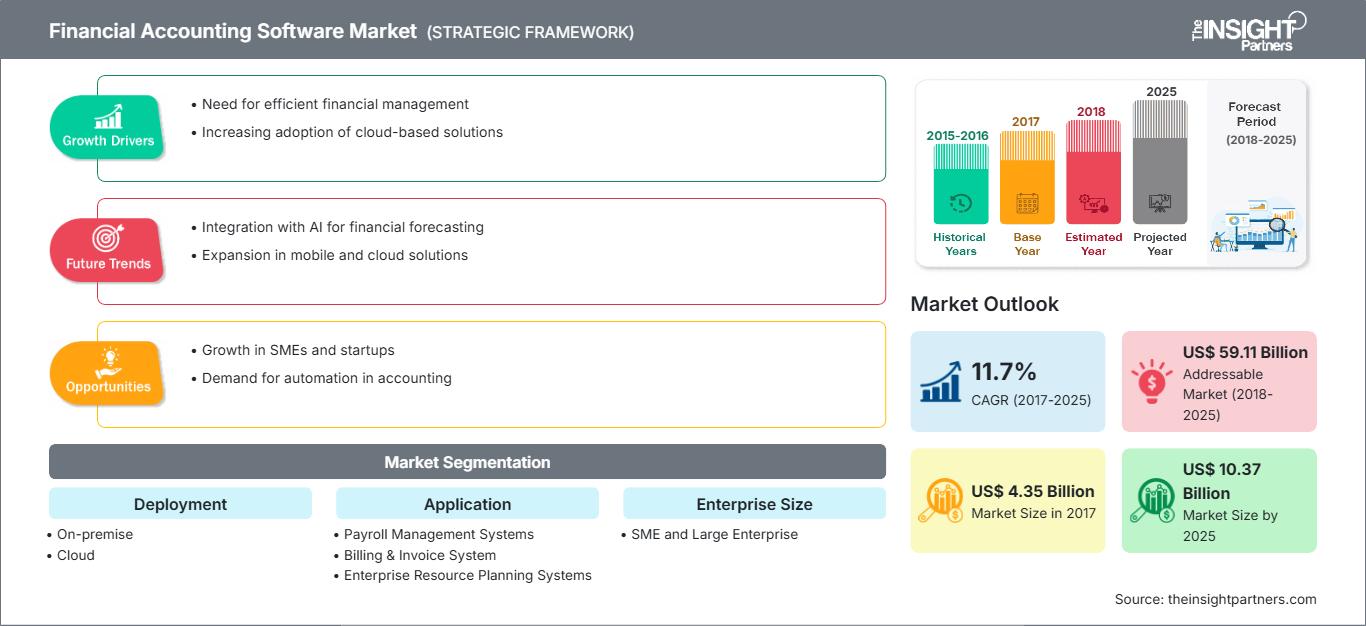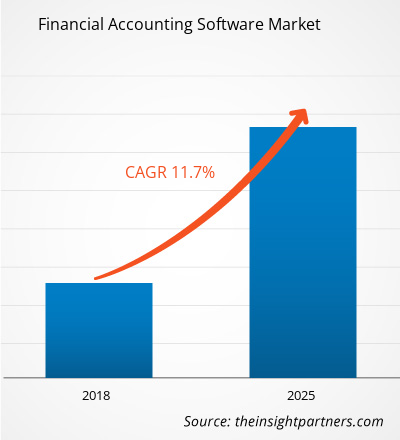Der globale Markt für Finanzbuchhaltungssoftware belief sich 2017 auf 4,35 Milliarden US-Dollar und wird im Prognosezeitraum 2018–2025 voraussichtlich mit einer durchschnittlichen jährlichen Wachstumsrate (CAGR) von 11,7 % wachsen und bis 2025 10,37 Milliarden US-Dollar erreichen.
Nordamerika war der führende geografische Markt und wird voraussichtlich im gesamten Prognosezeitraum den höchsten Umsatzbeitrag leisten. Rasante technologische Entwicklungen, zahlreiche Investitionen und unterstützende Regierungspolitiken im westlichen Teil der Welt haben die Dominanz Nordamerikas auf dem Markt für Finanzbuchhaltungssoftware begünstigt.Markteinblicke
Cloudbasierte Buchhaltungssoftware gewinnt an Bedeutung
Das Cloud-basierte Modell ermöglicht es Unternehmen, auf ein Pay-as-you-go-Modell umzusteigen, das die Höhe der Vorabgebühren erheblich reduzieren kann. Die vom Anbieter erhobenen Gebühren sind proportional zur Nutzung der Anwendungen und steigen mit zunehmender Nutzung. Die Kosten sind im Vergleich zum On-Premise-Modell stets geringer. Zudem entfallen bei diesem Modell Wartungs-, Reparatur- und Ausfallzeiten. Je nach Art der eingesetzten Anwendung können die Kosten erheblich sein, wenn mehrere Integrationen erforderlich sind und für einen reibungslosen Übergang Daten von alten Legacy-Systemen übertragen werden müssen.
Passen Sie diesen Bericht Ihren Anforderungen an
Sie erhalten kostenlos Anpassungen an jedem Bericht, einschließlich Teilen dieses Berichts oder einer Analyse auf Länderebene, eines Excel-Datenpakets sowie tolle Angebote und Rabatte für Start-ups und Universitäten.
Markt für Finanzbuchhaltungssoftware: Strategische Einblicke

- Holen Sie sich die wichtigsten Markttrends aus diesem Bericht.Dieses KOSTENLOSE Beispiel umfasst Datenanalysen, die von Markttrends bis hin zu Schätzungen und Prognosen reichen.
Steigende Nachfrage nach effizienten und dennoch kostengünstigen Lösungen für die Verwaltung buchhalterischer Aufgaben
Sie erhalten kostenlos Anpassungen an jedem Bericht, einschließlich Teilen dieses Berichts oder einer Analyse auf Länderebene, eines Excel-Datenpakets sowie tolle Angebote und Rabatte für Start-ups und Universitäten.
Markt für Finanzbuchhaltungssoftware: Strategische Einblicke

- Holen Sie sich die wichtigsten Markttrends aus diesem Bericht.Dieses KOSTENLOSE Beispiel umfasst Datenanalysen, die von Markttrends bis hin zu Schätzungen und Prognosen reichen.
Finanzbuchhaltungssoftware ermöglicht die Automatisierung systematischer Vorgänge zur Erfassung von Buchhaltungsdaten, Messung von Kennzahlen und Berichterstattung über die Finanzaktivitäten des Unternehmens. Die Software ist ein äußerst wichtiges Werkzeug für Buchhalter, da sie den Verwaltungsaufwand für die Buchhalter erheblich reduziert und für den Benutzer Kosteneffizienz bringt. In jedem Unternehmen, in dem eine Finanzbuchhaltungssoftware implementiert wurde, treten kritische Engpässe in der Buchhaltung auf, wie z. B. ungenaue Prüfungsinformationen oder die Nichteinhaltung interner und gesetzlicher Standards und deren Anforderungen. Buchhaltungssoftware wird daher immer als ein Vorteil angesehen, der Kosten senkt und die Produktivität steigert.
Da die Pflege herkömmlicher Buchhaltungssysteme für den Einzelnen mühsam war und die Geschäftsleitung zeitnah über die Erstellung von Steuerberichten informiert werden musste, war der Bedarf an einer effektiveren Lösung für dieses Problem deutlich größer geworden. Durch die Verwendung von Finanzbuchhaltungssoftware sind Sie nicht mehr auf menschliche Hilfe angewiesen, und Sie erhalten rechtzeitig steuerfreundliche Berichte.
Segmentierung nach Anwendungserkenntnissen
Unternehmen wachsen weltweit rasant, wodurch ein Bedarf an verschiedenen Softwarelösungen entsteht, die verschiedene Geschäftsvorgänge vereinfachen. Ein effizient verwaltetes Buchhaltungssystem ist für jedes Unternehmen wichtig, um den Buchhaltungsprozess schneller und reibungsloser zu gestalten. Auf Anwendungsbasis ist der globale Markt für Finanzbuchhaltungssoftware in Lohn- und Gehaltsabrechnungssysteme, Abrechnungssysteme, Warenwirtschaftssysteme sowie Zeit- und Kostenmanagementsysteme und weitere unterteilt. Die wichtigsten Funktionen von Abrechnungs- und Rechnungssystemen sind die Erstellung von Kundendatensätzen, vordefinierten Kommunikationsvorlagen, Währungseinstellungen sowie Rechnungs-, Zahlungs- und Steuerberichte. Die Implementierung dieses Systems ermöglicht die Reduzierung von Zahlungsverzug, minimiert Zahlungsausfälle und wahrt ein professionelles Image.
Einblicke in die Segmentierung nach Unternehmensgröße
Derzeit ist Finanzbuchhaltungssoftware ein entscheidender Teil jedes Unternehmenssystems für Gehaltsabrechnung, Cash Management, Steuermanagement, konzerninterne Buchhaltung, Währungsmanagement und vieles mehr. Diese Software bietet Organisationen verbesserte Optimierung, Geschwindigkeit, Geschäftszuverlässigkeit und Nachhaltigkeit. Auf Grundlage der Unternehmensgröße wird der globale Markt für Finanzbuchhaltungssoftware in kleine und mittlere Unternehmen (KMU) sowie große Unternehmen unterteilt. Der globale Markt für Finanzbuchhaltungssoftware nach Unternehmensgröße wurde im Jahr 2017 vom KMU-Segment angeführt und wird seine Dominanz im Prognosezeitraum bis zum Jahr 2025 voraussichtlich beibehalten.
Neue Marktinitiativen wurden als die am häufigsten angewandte Strategie auf dem globalen Markt für Finanzbuchhaltungssoftware beobachtet. Einige der jüngsten Marktinitiativen sind unten aufgeführt:
2018: Microsoft und Blackbaud kündigten eine gemeinsame Investition in die Integrated Cloud Initiative for Nonprofits an, die dazu beitragen soll, Cloud-Innovationen in den Bereichen zu beschleunigen, die kritische Marktanforderungen über den gesamten Lebenszyklus einer Mission hinweg erfüllen.
2018: NationalOilwell Varco, führender Anbieter von Ausrüstung, Technologie und Dienstleistungen für die globale Öl- und Gasindustrie, und Microsoft Corp. kündigten eine Vereinbarung zur Zusammenarbeit bei der digitalen Verbesserung der Vertriebsplattform und des Außendienstes von NOV an, um erstklassige Erfahrungen zu bieten. Dazu wird Microsoft Dynamics 365 genutzt, um Geschäftsprozesse zu optimieren, auf Echtzeitdaten und -erkenntnisse zuzugreifen und den Außendienst mit einem digitalen, mobilen Ansatz zu revolutionieren.
2018: Walmart und Microsoft kündigten eine strategische Partnerschaft an, um Walmarts digitale Transformation im Einzelhandel voranzutreiben. Walmart wählte Microsoft als strategischen Cloud-Anbieter und nutzt die gesamte Palette der Cloud-Lösungen von Microsoft.
FinanzbuchhaltungssoftwareRegionale Einblicke in den Markt für Finanzbuchhaltungssoftware
Die Analysten von The Insight Partners haben die regionalen Trends und Faktoren, die den Markt für Finanzbuchhaltungssoftware im Prognosezeitraum beeinflussen, ausführlich erläutert. In diesem Abschnitt werden auch die Marktsegmente und die geografische Lage in Nordamerika, Europa, dem asiatisch-pazifischen Raum, dem Nahen Osten und Afrika sowie Süd- und Mittelamerika erörtert.
Umfang des Marktberichts zur Finanzbuchhaltungssoftware
| Berichtsattribut | Einzelheiten |
|---|---|
| Marktgröße in 2017 | US$ 4.35 Billion |
| Marktgröße nach 2025 | US$ 10.37 Billion |
| Globale CAGR (2017 - 2025) | 11.7% |
| Historische Daten | 2015-2016 |
| Prognosezeitraum | 2018-2025 |
| Abgedeckte Segmente |
By Bereitstellung
|
| Abgedeckte Regionen und Länder | Nordamerika
|
| Marktführer und wichtige Unternehmensprofile |
|
Dichte der Marktteilnehmer für Finanzbuchhaltungssoftware: Verständnis ihrer Auswirkungen auf die Geschäftsdynamik
Der Markt für Finanzbuchhaltungssoftware wächst rasant. Die steigende Nachfrage der Endnutzer ist auf Faktoren wie veränderte Verbraucherpräferenzen, technologische Fortschritte und ein stärkeres Bewusstsein für die Produktvorteile zurückzuführen. Mit der steigenden Nachfrage erweitern Unternehmen ihr Angebot, entwickeln Innovationen, um den Bedürfnissen der Verbraucher gerecht zu werden, und nutzen neue Trends, was das Marktwachstum weiter ankurbelt.

- Holen Sie sich die Markt für Finanzbuchhaltungssoftware Übersicht der wichtigsten Akteure
Globaler Markt für Finanzbuchhaltungssoftware – Segmentierung
Globaler Markt für Finanzbuchhaltungssoftware – nach Bereitstellung
- On-Premise
- Cloud
Globaler Markt für Finanzbuchhaltungssoftware – nach Anwendung
- Lohn- und Gehaltsabrechnungssysteme
- Abrechnungs- und Rechnungssysteme
- Enterprise-Resource-Planning-Systeme
- Zeit- und Spesenmanagementsysteme
- Sonstige
Globaler Markt für Finanzbuchhaltungssoftware – nach Unternehmensgröße
- KMU
- Großunternehmen
Globaler Markt für Finanzbuchhaltungssoftware – Nach Geografie
Nordamerika
- USA Pazifik (APAC)
- Südkorea
- China
- Indien
- Australien
- Japan
- Übriger Asien-Pazifik
Naher Osten und Afrika (MEA)
- Saudi-Arabien
- VAE
- Südafrika
- Übriger Teil MEA
Süd Amerika
- Brasilien
- Argentinien
- Restliches Südamerika (SAM)
Markt für Finanzbuchhaltungssoftware – Unternehmensprofile
- Microsoft Corporation
- Oracle Corporation
- FreshBooks, Inc.
- Infor
- INTUIT, INC.
- LucaNet AG
- Xero Limited
- The Sage Group plc
- Wave Financial Inc.
- Zoho Corporation
- Historische Analyse (2 Jahre), Basisjahr, Prognose (7 Jahre) mit CAGR
- PEST- und SWOT-Analyse
- Marktgröße Wert/Volumen – Global, Regional, Land
- Branchen- und Wettbewerbslandschaft
- Excel-Datensatz
Aktuelle Berichte
Verwandte Berichte
Erfahrungsberichte
Grund zum Kauf
- Fundierte Entscheidungsfindung
- Marktdynamik verstehen
- Wettbewerbsanalyse
- Kundeneinblicke
- Marktprognosen
- Risikominimierung
- Strategische Planung
- Investitionsbegründung
- Identifizierung neuer Märkte
- Verbesserung von Marketingstrategien
- Steigerung der Betriebseffizienz
- Anpassung an regulatorische Trends






















 Kostenlose Probe anfordern für - Markt für Finanzbuchhaltungssoftware
Kostenlose Probe anfordern für - Markt für Finanzbuchhaltungssoftware